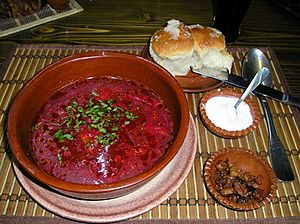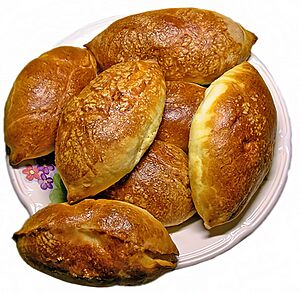Soviet cuisine facts for kids

Soviet cuisine was the common food style in the Soviet Union. It mixed different food traditions from all the countries that made up the Soviet Union. This happened as the "Soviet people" identity was forming. Soviet food often used fewer ingredients and was simpler to cook.
You could find this type of food in canteens all over the Soviet Union. It also became a big part of home cooking, especially in cities. People often ate Soviet dishes alongside their own traditional national foods. Soviet cuisine was shaped by how people ate and by the limited food available in many parts of the USSR. Many dishes were simpler versions of French, Russian, and Austro-Hungarian foods. Foods from the Caucasus region, like Georgian cuisine, also added to it. Government-run canteens were called stolovaya.
In Western countries, Soviet cuisine is sometimes thought to be the same as Russian cuisine. However, Russian food is its own distinct style.
Contents
How People Ate in the Soviet Union
A typical Soviet meal, like lunch or dinner, usually had three parts. These were called "first," "second," and "third" courses. A salad was sometimes eaten but not numbered. In Russian cuisine, salads are part of a separate course called zakuski.
In a restaurant, you could order anything you wanted. But in a regular canteen, especially for workers or students, you would often get a "combined lunch" (kompleksny obed).
- The first course was a soup or broth. This was considered the "liquid" part of the meal.
- The second course was "solid" food. This included meat, fish, or poultry. It came with a side dish called a "garnish" (Russian: гарнир). Common garnishes were potatoes, buckwheat kasha, or macaroni. Bliny, baked dishes (zapekanka), or eggs could also be a second course.
- The third course was supposed to be a dessert. But in canteens, it was usually a sweet drink. This could be tea, coffee, kompot, milk, or kefir.

Fresh green vegetables and salads were mostly eaten when they were in season. Some exceptions were sauerkraut-based salads, as sauerkraut was available all year. Spices were not used much, except for a little mustard and black pepper. Food generally had a mild taste.
There were no big differences between breakfast, lunch, and dinner. Lunch always started with soup. A tradition called "fish day" began on Thursdays in state canteens. On this day, fish or seafood was served instead of meat. This helped with meat shortages. This tradition also spread to many homes.
The common idea, which is still somewhat true in Russia today, was to eat a lot at each meal. People ate fewer times a day. They were told not to snack between meals. Doctors in the Soviet era believed that snacking would spoil appetite, especially for children. They also thought it could cause indigestion. A typical lunch might have chicken soup or borscht for the first course. The main course could be fried meatballs or goulash with boiled potatoes or buckwheat porridge. Butter or sour cream was often used as a sauce.

Holiday meals were often based on old French and Russian recipes. They used a lot of rich sauces, marinated meats, and melted cheese. Mixing ingredients and long cooking times were common, just like in classic French cooking. A lot of effort went into preparing these special meals. Having a rich holiday table was often a matter of family pride.
Popular Soviet Dishes

Snacks and Salads (Zakuski)
- Olivier (also known as Russian salad)
- Herring under a fur coat
- Kholodets (meat jelly)
- Vinegret (beetroot salad with onions, pickles, potatoes, carrots, dressed with sunflower oil)
- Vitaminniy salat (Vitamin salad) - a cabbage salad with seasonal vegetables.
- Various pickles, like cucumbers, tomatoes, ramsons, and mushrooms.
- Sauerkraut mixed with carrots, served as a salad.
- Morkovcha (Korean carrot salad) - a spicy carrot salad.
First Course (Soups)
- Borscht (Ukrainian soup)
- Chicken noodle soup
- Kharcho (Georgian beef soup)
- Okroshka (cold soup)
- Pacha (Armenian/Azerbaijani/Georgian soup)
- Pea soup
- Rassolnik (pickle soup)
- Shchi (Russian cabbage soup)
- Solyanka (thick, spicy and sour soup)
- Sorrel soup
- Ukha (fish soup)
Second Course (Main Dishes)
- Beef Stroganoff
- Chicken Kiev (a filled chicken cutlet)
- Cutlet or meat ball
- Various kinds of dumplings:
- Goulash, ragout, or other kinds of stews
- Golubtsy (cabbage rolls stuffed with rice and meat in tomato sauce)
- Plov (Uzbek rice dish)
- Sausages
- Shashlik (grilled meat skewers from the Caucasus)
Third Course (Drinks)
These were usually served in a 200 millilitres (7.0 imp fl oz; 6.8 US fl oz) glass in canteens.
- Cocoa
- Coffee with milk (black coffee cost extra)
- Kefir (fermented milk drink)
- Kissel (a thick fruit drink)
- Kompot (fruit drink)
- Kvass (fermented beverage)
- Milk
- Ryazhenka (Ukrainian baked milk drink)
- Tea
Desserts
- Buns, biscuits, cookies, sushki (dry bread rings)
- Cakes (e.g., Kyiv cake, Napoleon, Medovik)
- Halva (sweet confection)
- Pirozhki (small baked or fried buns with filling)
Breakfasts
- Sausages
- Blini (thin pancakes) or Oladyi (thicker pancakes)
- Various kinds of porridge, like buckwheat kasha with milk
- Syrniki (fried cheese pancakes)
Street Food
Images for kids
-
Solyanka with olives
-
Typical vegetable salad made of tomatoes, cucumbers, onions, and dressed with smetana
-
Zakuski at a celebration table
-
Kvass street vendor in Vladikavkaz
See also
 In Spanish: Gastronomía de la Unión Soviética para niños
In Spanish: Gastronomía de la Unión Soviética para niños

















